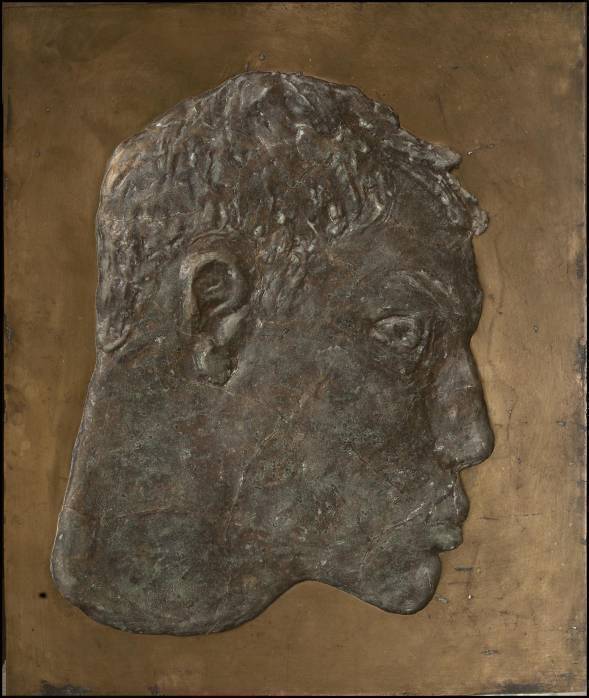Boris Pasternak

Lebedeva, Sarah
1892 - 1967
Boris Pasternak
Bronze relief
c 35cm high
1961 - 1963
PROVENANCE:
Descendants of the artist
LITERATURE:
Sarah Lebedeva, Compiled by M.V. Alpatov and others, Sovietsky Khudozhnik Publishing House, Moscow, 1973, illustrated plates 110 & 111.
Tretyakov Gallery, Sculpture Catalogue, Vol II, No. 1060, illustrated p. 293.
Certificate Luidmilla Victorovna Martz, Curator of Sculpture, Tretyakov Gallery.
Sarah Lebedeva in 1910 - far left
This image of Boris Pasternak is considered the masterpiece from the last years of the leading Soviet period sculptor, Sarah Lebedeva. In the above mentioned book on Sarah Lebedeva published by Sovietsky Khudozhnik Publishing House in 1973, M.V. Alpatov writes, "her last work, which, luckily she was able to complete, seems to me the peak of her career. It is the tombstone for the grave of Boris Pasternak, executed in limestone in the technique of intaglio. (I shall remark that a bas relief - a preparatory study - is hardly inferior to the finished work artistically). The tombstone looks like an antique Greek gem carving and at the same time it conveys the very essense of the image of this remarkable poet of our times." Lebedeva was born two years after Pasternak and she was a friend of his all her life. When asked to make this image of Pasternak for his tomb the year after his death, she portrayed him as she had known him as a young man.
Pasternak is depicted in our bronze relief in profile. Lebedeva started by making a preparatory drawing.
Preparatory drawing pricked for transfer.
She then executed the work in plaster and limestone. In the late 1960's/early 1970's the Tretyakov asked V. Lukyanov at the studios of the Palace of the Soviets to cast it in bronze. A couple of further versions were cast in bronze in the 1980's of which ours is one.
Plaster
Limestone/Sandstone
Sarah Lebedeva (b St Petersburg, 23 Dec 1892; d Moscow, 7 March 1967) trained in St Petersburg in the studio of Leonid Shervud as well as in other studios. From 1925 she lived and worked in Moscow. In her mature works impressionistic modelling, extraordinarily sensitive to surface nuances of texture and light and shade, blends with a structural logic that bears witness to a heartfelt absorption of the lessons of Cubism.
Lebedeva in her studio in 1935
The profoundly psychological quality of Lebedeva’s work springs from her expressive modelling of her material and endows her subjects with a symbolic significance, while in no way overshadowing their individuality. For example, her bronze portrait of the chief of the secret police, Feliks Dzerzhinsky (1925; Moscow, Tret’yakov Gal.), is a striking embodiment of a menacing and merciless power. Lebedeva created a remarkable portrait gallery of personalities prominent in Russian culture (e.g. S. Mikhoels , 1939; A. Tvardovsky , 1943; both bronze, Moscow, Tret’yakov Gal.; and V. Tatlin , limestone, 1943–4; St Petersburg, Rus. Mus.).
The headstone for the grave of Boris Pasternak at Peredelkino, near Moscow, a stele, severe in its form, with a romantic, emotionally charged portrait of the poet in deep relief, is among the best examples of Russian memorial sculpture.
Lebedeva also created sculptures of a neo-classical equilibrium, such as the famous Girl with Butterfly (plaster, 1935–6; hammered copper, 1956; St Petersburg, Rus. Mus.), and models for decorative items and sculptures in glazed earthenware (1934–6).
Boris Leonidovich Pasternak (1890-1960), born in Moscow, was the son of talented artists: his father a painter and illustrator of Tolstoy's works, his mother a well-known concert pianist. Pasternak's education began in a German Gymnasium in Moscow and was continued at the University of Moscow.

Under the influence of the composer Scriabin, Pasternak took up the study of musical composition for six years from 1904 to 1910. By 1912 he had renounced music as his calling in life and went to the University of Marburg, Germany, to study philosophy. After four months there and a trip to Italy, he returned to Russia and decided to dedicate himself to literature.
Pasternak's first books of verse went unnoticed. With Sestra moya zhizn (My Sister Life), 1922, and Temy i variatsii (Themes and Variations), 1923, the latter marked by an extreme, though sober style, Pasternak first gained a place as a leading poet among his Russian contemporaries. In 1924 he published Vysokaya bolezn (Sublime Malady), which portrayed the 1905 revolt as he saw it, and Detstvo Lyuvers (The Childhood of Luvers), a lyrical and psychological depiction of a young girl on the threshold of womanhood. A collection of four short stories was published the following year under the title Vozdushnye puti (Aerial Ways). In 1927 Pasternak again returned to the revolution of 1905 as a subject for two long works: Leytenant Shmidt, a poem expressing threnodic sorrow for the fate of Lieutenant Schmidt, the leader of the mutiny at Sevastopol, and Devyatsot pyaty god (The Year 1905), a powerful but diffuse poem which concentrates on the events related to the revolution of 1905. Pasternak's reticent autobiography, Okhrannaya gramota (Safe Conduct), appeared in 1931, and was followed the next year by a collection of lyrics, Vtoroye rozhdenie (Second Birth), 1932. In 1935 he published translations of some Georgian poets and subsequently translated the major dramas of Shakespeare, several of the works of Goethe, Schiller, Kleist, and Ben Jonson, and poems by Petöfi, Verlaine, Swinburne, Shelley, and others. Na rannikh poyezdakh(In Early Trains), a collection of poems written since 1936, was published in 1943 and enlarged and reissued in 1945 as Zemnye prostory (Wide Spaces of the Earth). In 1957 Doktor Zhivago, Pasternak's only novel - except for the earlier "novel in verse", Spektorsky (1926) - first appeared in an Italian translation and has been acclaimed by some critics as a successful attempt at combining lyrical-descriptive and epic-dramatic styles. An autobiographical sketch,Biografichesky ocherk (An Essay in Autobiography), was published in 1959, first in Italian, and subsequently in English. Pasternak lived in Peredelkino, near Moscow, until his death in 1960.







